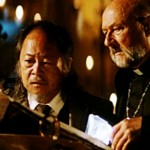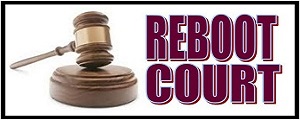
THE STORY:
In the future year of 2013 — that's right, kiddos, Escape from L.A. takes place right now! — the United States has become a theocracy, led by an overly religious, power-mad President-for-life who has outlawed things like smoking, drinking, foul language, sex outside of marriage and being anything other than a Christian. Those found unfit to live in the new moral America are deported to Los Angeles, which is now an island thanks to a massive earthquake and no longer considered part of the U.S. When the President's daughter and the box that controls the country's newest super-weapon go missing inside L.A., legendary hard-ass Snake Plissken (Kurt Russell) is sent in to recover the box and eliminate the girl, who's shacked up with an anti-U.S. revolutionary, before the amassed armies of several third-world countries converge on America's border.
OUR TAKE:
There are two big impediments to loving director John Carpenter's 1996 sequel Escape from L.A. The first is that it's a beat-by-beat remake of its predecessor. Nearly every single character or plot point from Escape from New York has an L.A. doppelganger. Ernest Borgnine's taxi driver becomes Steve Buscemi's Hollywood tour guide. Microscopic explosives become the Plutoxin-7 virus. A gladiator fight becomes a deadly basketball contest. (Yeah, not exactly a fair swap with that last one.) Barring a few minor late-in-the-game twists, L.A. is more of a remake than a sequel.
The second is the beyond-horrible CGI littered throughout the film. In the wake of Jurassic Park, computer-generated effects became all the rage in the mid-90s, and a slew of films jumped on the CGI bandwagon despite having neither the budget nor a knowledgeable enough effects department to pull them off. Escape from L.A. falls hard into this trap. There's a submarine sequence that looks more like a pre-viz schematic of a scene than it does an actual finalized piece of effects work. Now, you can dismiss this by saying, "Yeah, well, the effects in Escape from New York aren't good either." That's true, but practical effects work, even if it's not top-shelf, ages much better than bad, mid-90s CGI, which has a tendency to yank you right out of the movie. (There's also a fair amount of dodgy green-screen work that doesn't help either.)
But if you can get past those two things, you'll find Escape from L.A. is a far better sequel than most will give it credit for. It's gonzo in all the right ways, as Snake must contend with not just your typical post-apocalyptic goons, but also an irradiated surfing gang, a plastic-surgery-obsessed cult and a butt-kicking transsexual gang leader named Hershe who is played by Pam Grier. Even better is the fact that the film's vision of 2013 is downright prescient. L.A.'s 2013 is a place where you can get kicked out of America just for being a Muslim (as happens to Valeria Golina's character, Taslima). Isn't that the kind of country that today's scariest right-wingers are actively campaigning for? Would it really be that hard to imagine Cliff Robertson's Bible-thumping president being the front-runner in the real-world Republican primaries? Honestly, I don't think it would be. Escape from L.A. was no doubt intended to be satirical upon release, but its viewpoint has been made to appear sharper thanks to some of the turns this country has taken in the 17 years since.
Additionally, the movie's just flat-out fun. Complain all you want about Snake surfing and hang-gliding and doing all types of preposterous things, but I'd argue that once you move the setting from New York to Los Angeles, Carpenter, who also co-wrote the script, had no choice but to lighten things up. And he takes great advantage of the setting by giving us apocalyptic versions of a number of L.A. locales, including an underwater Universal Studios (complete with shark!) and a thinly-disguised Disneyland. Thanks to its colorful characters and more elaborate sets, Carpenter's version of future L.A. feels far more alive than his version of New York, which was really just a burnt-out husk of a city. Interestingly, what would have made sense would have been to go dark again with the series' talked-about third installment, Escape from Earth. In most film trilogies, it's the second film that's the dark one. An Escape trilogy could have been notable for doing the polar opposite. Unfortunately, L.A. bombed and Earth was never to be.
Although if it had to end here, it's hard to think of a better send-off for Snake. The film's awesomely ballsy finale has Snake using the U.S. government's own weapon to plunge the world into a permanent black-out. While the President and his military goons freak out, Snake casually lights a cigarette with the matches that came with his supplies at the beginning of the film. "Welcome to the human race," indeed.

IS THERE A BADASS?
Uh, yeah … I'd say so. What's great about Escape from L.A. is it doesn't mess with Snake Plissken the character. He's the same grizzled, relentless, no-nonsense Snake we all met in the first film. He has one goal: To survive to the next minute. That's it. Carpenter and Russell don't try to give the character any extra dimensions or new weaknesses. Nor do they neuter him in any capacity. Snake is just older and surlier here — both of which suit the character just fine.
CREEP-OUT GROTESQUERIES:
The deformed plastic-surgery cultists are kind of disgusting, as are all the extra eyes, heads and extraneous body parts Bruce Campbell's Surgeon General of Beverly Hills has lying around that are very briefly glimpsed. Besides for that, Escape from L.A. is largely (and surprisingly) gore-free.
CASUALTIES:
Somewhere in the neighborhood of 30. Snake personally snuffs out seven dudes, including four at one time when they fall for the old "Bangkok rules" trick. Taslima gets shot in the back. Some guy gets his head cut off (off-screen) with a pair of gnarly looking gardening shears. Another poor sap is blown away for sucking at basketball. Six of Hershe's crew are killed. The anti-U.S. revolutionary, Cuervo Jones, can be presumed dead after Buscemi's character plugs him in the chest. And it looks like at least 10 dudes don't survive Snake and company's final raid on Disneyland.
WHAT ABOUT THE SCORE?
The score, by Carpenter and his Memoirs of an Invisible Man composer, Shirley Walker, is kind of all over the place. The film opens with a synth-laden callback to the original Escape from New York. However, the electronica eventually gives way to a kind of modern-Western score, complete with Tex-Mex electric-guitar noodling. Then there's a bunch of traditional big orchestral stuff as the movie wraps up. It's solid, if not among Carpenter's best.
THE FINAL CUT:
Label it a "guilty pleasure" if you must, but I take great umbrage with those who write off this fun and vibrant sequel as an unworthy follow-up to Escape from New York. Carpenter and Russell didn't try to do much new here from a plot perspective, but they clearly had something to say about the potential future state of America and enjoyed splashing around in Plissken's universe with a bigger budget to play with. This is the only sequel Carpenter officially directed, and it makes for a fine companion piece to the original film.
It also has one of the best trailers ever:











